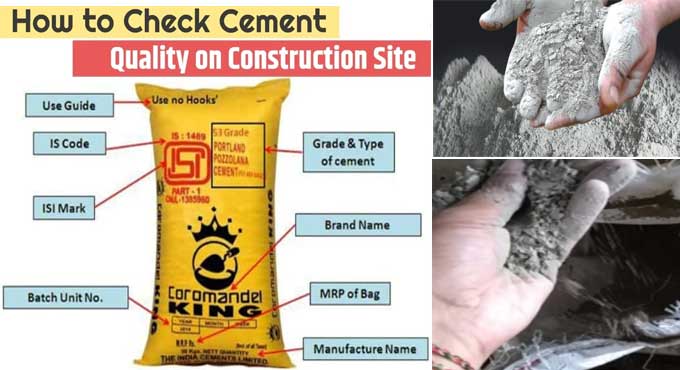NEWS | SOFTWARE | SHEET
The Top 10 Methods for Checking Cement Quality on Construction Sites
The quality of cement used in a project must check in the field before its implementation. Construction sites cannot provide a comprehensive evaluation of cement's engineering properties.
Any construction project requires cement. Aggregate and sand are bonded together by it in concrete. There are indeed many theories that explain how to measure cement quality. However, most of them require large instruments to measure cement quality in labs.
A site visit cannot establish all the properties of cement, but some preliminary field tests can offer some insight into cement quality. These simple tests can be carried out on-site easily without apparatus to assess the cement's quality. Cement properties affecting the quality and strength of cement are checked in these preliminary tests.
Test on cement at construction site
A. Manufacturing Date
According to several studies, cement's strength decreases over time. The IS Specifications state that cement that has been stored for over three months should retest. It is generally recommended to use cement within 90 days of its production date.
B. Lumps Checking
Moisture in cement causes lumps to form. In the presence of atmospheric moisture, cement undergoes a chemical reaction called hydration. Cement is susceptible to moisture damage. As soon as it becomes hydrated with water, the cement becomes useless.
Lumpiness in cement is an indication that it has become moist. It is therefore recommended to avoid cement bags that contain small and hard lumps. A set of cement lumps indicates that cement has been set.
C. Rubbing Test
Rub a pinch of cement between your fingertips, it should feel smooth as you rub it. If the surface is rough, cement and sand had been mixed.
D. Hand Checking
Place your hand inside the cement bag. It must feel cool to you. Hence, it implies that the cement bag is not undergoing any hydration reaction.
E. Smell Test
You can smell a pinch of cement, and if it gives off an earthy smell, it indicates that it contains a high amount of pounded clay and silt.
F. Floating Test
You can test the quality of cement by throwing a handful in water. Good quality cement will sink but not float.
G. Cement Color
Uniformity is necessary for cement's color. The cement should have a grayish tone with a lighter shade of green. Cement’s color indicates whether it has too much clay or lime.
H. Strength Test
You need to make a block of cement that is 25 mm wide, 25 mm high, and 200 mm long. The block should be immersed in water for 7 days. As you load the block, place it on supports 15000 mm apart and then place 340 N on it. It should not show any signs of failure if the block is made of quality cement.
I. Shape Test
The cement is also known as hydraulic cement since it is able to set underwater as well. Add a little water to 100 g of cement to make a stiff paste. Placing a cement cake on a glass plate will ensure the edges will be sharp. Fill the bucket with water and immerse the plate.
It is important to observe that the shape should not be disturbed during settlement. Water should not affect cement's ability to set or gain strength.
J. Specific Gravity
If cement is to be stored beyond three months, it is important to figure out its specific gravity. The Specific gravity of a good cement should be between 3.1-3.6 grams per cubic centimeter.
To get more clear ideas, go through the following exclusive construction video tutorial.
Lecturer: F&U-FORYOU
Recommended Articles:
How to Calculate Cement Sand & Aggregate Quantity in Concrete
Recommended Articles:
Estimation of the amount of cement, sand and aggregate in plain concrete


